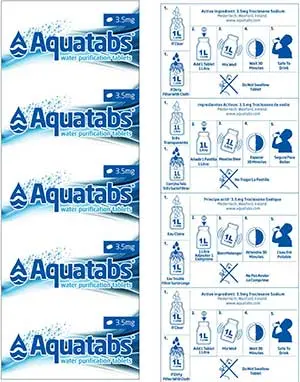
Aquatabs 3.5mg 2 Strips
Aquatabs Water Purifying Tablets 3.5mg
EXPIRY 12/2027
1 tablet is required for 1 litre of water.
You are getting 2 strips of 10 tablets
Aquatabs can be used for Emergency or disaster, Peacekeepers, Defence Force, Cadets, while travelling, camping, or general household use.
where water-borne disease is a problem, then Aquatabs has been proven to be an effective solution in rendering water safe to drink.
Aquatabs have been tried and tested in a wide range of natural and polluted water sources.
Aquatabs are effervescent tablets that rapidly dissolve in water to kill micro-organisms that cause diarrhoea, no need to boil water.
They are effervescent (self-dissolving) tablets, the US EPA approved active ingredient is NaDCC
which is also known as Sodium Dichloroisocyanurate or Troclosene Sodium .
The compositions of Aquatabs are in conformance to international standards.
-1 Litre of Water Treated per Tablet
Note: If water is visibly contaminated or bilharzia is known to be present use a stronger version of Aquatabs
DIRECTIONS:
Add 1 tablet to 1 litre of clear water. Leave for 30 mins before use. Where there is sediment in the water, allow the water to settle or filter through a fine cloth. The filtered water is then treated.
1. 1 Litre of water.
2a. If clear, add 1 tablet.
2b. If dirty filter with cloth, add 2 tablets.
3. Mix well.
4. Wait 30 Minutes.
5. Safe to drink.
USAGE ADVICE:
Do not swallow tablet.
PRODUCT WARNINGS:
Causes serious eye irritation:
If in eyes:
Rinse cautiously with water for several minutes.
Remove contact lenses, if present and easy to do.
Continue rinsing.
If eye irritation persists, Get medical advice/attention.
CAUTION:
Contact with combustible materials may cause fire, irritation to eyes and respiratory system.
Toxic to aquatic life with long lasting effects.
Returns are not accepted on pharmaceutical products.
How do I use Aquatabs?
For water purification / disinfection
If the water is relatively clear / clean then a dosage rate of 2mg of chlorine per litre can be used. If the water is dirty it should either be filtered through a cloth such as a t-shirt or allowed sit until the sediment settles down and then decant off the clear water. Where dirty water needs to be treated or the water is suspect 5mg of chlorine per litre dosage rate should be used.
| For surface disinfection in Kitchens Dose at a concentration of 100mg of chlorine per litre |
For high risk hospital areas
Dose at a concentration of 1000mg of chlorine per litre
For general hospital /clinical surface disinfection
Dose at a concentration of 200mg of chlorine per litre
For fruit & vegetable disinfection
Dose at a concentration of 50mg of chlorine per litre
What is the shelf-life of Aquatabs?
In tropical and temperate conditions Aquatabs have a five year shelf-life in strip packs and a three year shelf-life in tubs. All tablet products should be protected from exposure to temperature extremes or high humidity.
Can I use Aquatabs when I am pregnant?
Yes – you can safely consume water treated by Aquatabs within the normal dosage levels.
What do I do if I have swallowed Aquatabs?
Drink plenty of milk or water. Although Aquatabs are non-toxic, as ever with these matters you should always seek medical advice at your earliest opportunity.
Is boiling water ok?
Bringing water to a rolling boil will kill most micro-organisms and make the water safe to drink. However, the fuel needed to bring water to a boil may cost more than Aquatabs and long-term use can damage the environment. Unlike water treated with Aquatabs cooled boiled water has no residual disinfectant and can be easily recontaminated.
Can Aquatabs be used in very cold temperatures?
Yes
What are Puritabs?
Puritabs are an old technology / formulation water purification tablets previously manufactured by Schering Plough. Since the takeover of the NaDCC formulation business by Medentech from Schering Plough, many customers previously purchasing Puritabs have transferred their purchases to Aquatabs.
What is NDM-1?
Some confusion exists regarding NDM-1 (New Delhi metallo-beta-lactamase). NDM-1 is not a virus. It is an enzyme which makes gram negative bacteria such as Klebsiella pneumonia or E. coli resistant to antibiotics. The gene for NDM-1 is a member of a large family of genes that encodes beta-lactamase enzymes called carbapenemases. Bacteria that produce carbapenemases are frequently referred to “superbugs” because infections caused by them are difficult to treat with antibiotics. Both of these bacteria are easily neutralized by Aquatabs Multipurpose, Klorkleen, or Klorsept Tablets and used in accordance with instructions will kill NDM-1 “superbugs” on surfaces in a wide range of environments including clinical settings such as hospitals.
NDM-1 was first identified in December 2009 in a patient hospitalised in New Delphi with an infection caused by Klebsiella pneumoniae. It was later detected in bacteria in India, Pakistan, the United Kingdom, the United States, and Canada. The most common bacteria that make this enzyme are Gram negatives such as Escherichia coli and Klebsiella pneumoniae, but the gene for NDM-1 can spread from one strain of bacteria to another by horizontal gene transfer. (ref Kumarasamy KK, Toleman MA, Walsh TR, et al. (August 2010). “Emergence of a new antibiotic resistance mechanism in India, Pakistan, and the UK: a molecular, biological, and epidemiological study”. Lancet Infect Dis 10 (9): 597–602.)
What if someone swallows a tablet?
Have them drink milk ( or if not available drink water) and seek medical advice.
Do you need to rotate the disinfectant with other disinfectants?
No. Germs cannot build up resistance to Medentech tablet disinfectants
Is warm water better?
Tablets dissolve faster in warm water, but don’t make it warmer than lukewarm
What do I do if a tablet is broken?
No problem just put the pieces in the container and add water